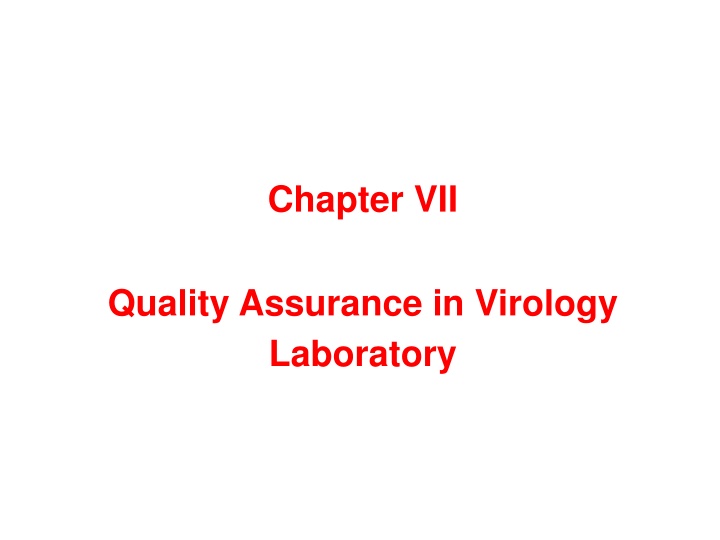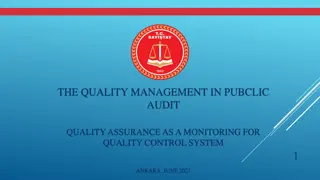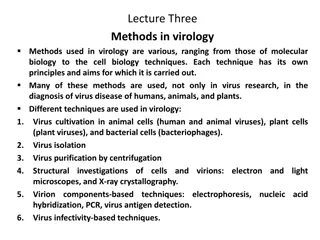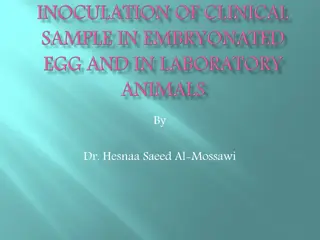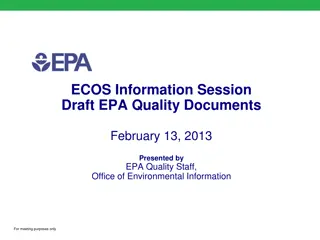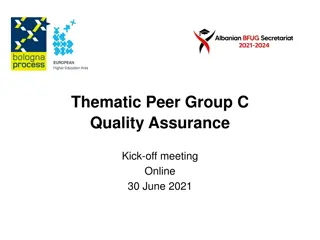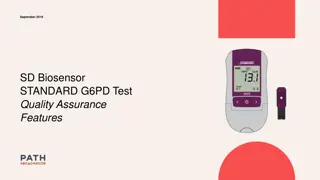Quality Assurance in Virology Laboratory
This chapter focuses on quality assurance in virology laboratory, covering topics such as quality control, documentation of test results, laboratory safety rules, and more. It explains the types of quality control, quality assurance cycle, and process areas of quality assurance in laboratory testing. The pre-analytic phase, which includes specimen collection and documentation, is detailed with examples of specimen collection methods for virus detection.
Download Presentation

Please find below an Image/Link to download the presentation.
The content on the website is provided AS IS for your information and personal use only. It may not be sold, licensed, or shared on other websites without obtaining consent from the author.If you encounter any issues during the download, it is possible that the publisher has removed the file from their server.
You are allowed to download the files provided on this website for personal or commercial use, subject to the condition that they are used lawfully. All files are the property of their respective owners.
The content on the website is provided AS IS for your information and personal use only. It may not be sold, licensed, or shared on other websites without obtaining consent from the author.
E N D
Presentation Transcript
Chapter VII Quality Assurance in Virology Laboratory
Acknowledgment Addis Ababa University Jimma University Hawassa University Haramaya University University of Gonder American Society of Clinical Pathology(ASCP) Center for Disease Control and Prevention(CDC)
Learning objectives At the end of this chapter, the student should be able to: 1. Define quality control. 2. List steps in quality control. 3. Explain way of documentation of laboratory test results. 4. Describe laboratory safety rules in virology laboratory.
Outline Quality control. Steps in conducting of quality control in virology laboratory. Recording and reporting of laboratory test results. Laboratory safety issues in virology laboratory.
Definitions Quality control(Q.C): It is the assessment of the laboratory work to ensure that the final result is accurate, reliable and precise. Types of Q.C 1. External QC (EQC ) : The reference control lab. send specimens to all city laboratories and then collect them and check the results with the ideal one. 2. Internal QC (IQC): Every lab. should have an internal QC. In it specimens prepared by Q.C officer and distributed to all benches as a normal sample (routine specimens) and then collected and checked.
Quality assurance (Q.A.): It is the summation of QC, IQC and EQC. QA = QC + IQC + EQC The Quality Assurance cycle illustrates quality systems. There are three process areas of QA in laboratory testing: Pre-analytic Analytic Post-analytic
A. Pre - analytical This is the part of QC before starting the real analysis of patient sample and it include: collection of specimens, documentation of test results & reporting Collection of specimens Specimens collected for virus detection take the form of: Swabbing of lesion site (skin, throat) with swab head transferred to viral transport medium which should contain protein, antibiotics (streptomycin, gentamicin, etc).
Scraping of lesion to obtain infected cells (base of vesicles, corneal ulcer). Aspirates of secretions or exudates (from posterior nasopharynx, conjunctiva, cervix). Urine & faeces. Blood, fluids (CSF, semen, saliva).
The container & the request form should be labelled Each request form should contain the following: Full name Medical record number , or hospital number Date and time of collection of sample Age & sex Occupation Diagnosis (clinical significance) possible aetiology Types and number of samples collected. Test requested
Transportation of virological specimen Specimens for isolation of infected virus should be transported to the lab. without delay. During transportation over long distances, optimum preservation of infectivity is obtained by placing the container in melting ice or refrigerating the sample at 40C. In general, freezing the specimen should be avoided but if there is a delay of more than 48 hr, specimen should be frozen at -70 0C not at - 200C.
B. Analytical It is the part of QC from receiving the specimen until the end of examining it. The analytical part include 4 steps: 1. Reception of specimen 2. calibration of instruments (weekly or monthly & yearly) 3. Follow-up laboratory safety rule 4. Proper examination of specimens & selection of the proper tests
Calibration of instruments In virology lab. we should have biology safety cabinet type 2 & should be disinfected each day & calibrated each month Incubators: virology lab should have CO2, O2, 370C incubator and oven. Temperature should be checked each day by Thermometer Centrifuge: speed should be checked by tachometer & time by stop watch. Refrigerator, freezers (deep freezers), liquid nitrogen: Daily checking of internal temperature using an electronic thermometer.
Sterilisation equipments: such as autoclaves, hot air oven. Serology instruments: instruments for performing ELISA test , ELISA plate washer, ELISA plate reader. Molecular virology instruments: PCR machine (Thermal cycler), Extraction machine, Gel photographer system, gel preparation and running equipments, Smart cycler (Tagman), Sequencing machine Other equipments: water bath, shaker, shaker incubator, heating block, microwave
Safety Precautions Route of infection in the lab. are 3: inoculation, ingestion & inhalation. Inoculation: This mean accidental introduction of infection into the body by a breach of any epithelial surface. Thus it covers the introduction of infection into eyes by splashing or fingers, injection through the skin by needle stick injury, bite of ectoparasite, incision with a sharp instrument or broken glass. 2) Ingestion: Infection by mouth may take place by the licking, sucking or accidental swallowing of infective material by splashing on to the lips from touching the mouth with contaminated fingers, pen or pencils, by licking label contaminated by the fingers or by using the mouth in pipetting infected fluids.
3. Inhalation: Infection may take place by the breathing in of infected aerosol, droplet nuclei or dust. The removals of a wet stopper, screw cap, the explosion of residual fluid from a pipette, letting fluid fall in drops into a container all of theses can expose to inhalation of infectious agents. According to the ACDP (Advisory Committee on Dangerous Pathogen) and EU (European Union) the micro organisms classified into 4 hazard groups: GROUP 1: Organisms that unlikely to cause human disease.
GROUP 2: Organism cause disease and hazard to lab. workers but not spread in the community and has prophylaxis and treatment. GROPU 3: Organism cause severe human disease, cause hazards to lab. workers, spread in community, but has effective prophylaxis and treatment GROUP 4: Organisms cause very severe human disease and serious risk to lab. workers and very severe if spread to community. e.g Filovirus (Ebola), Arenavirida (Lassa fever)
C. Post analytical It is the last part of QC & it include 2 steps. 1. Reporting of the result 2. Sending of the result
Summary of QC Steps ANALYTICAL POST ANALYTICAL PRE ANALYTICAL 1. Reception of specimens 1. Reporting of the results. 1.Collection of specimens 2. Calibration of instruments. 2. Sending out the results. 2. Documentation of request. 3. Follow-up laboratory safety rule 3. Transportation of specimen. 4. Examination of specimens. 18
References Basic Virology. Edward K. Wagner, third edition, 2006. Hoffmann - Rockstroh Kamps. HIV Medicine, 2007 Jawetz, Melnick, & Adelberg's. Medical Microbiology, 24th Edition by Vishal , 2000. Lawrence Corey. Handbook of diagnostic virology testing. Department of Laboratory Medicine Services Programs. Third Edition, 2004. Principles and Practice of Clinical Virology. Sixth edition, A John Wiley & Sons, Ltd., Publication, 2009.
